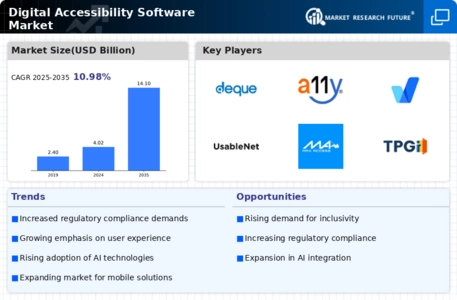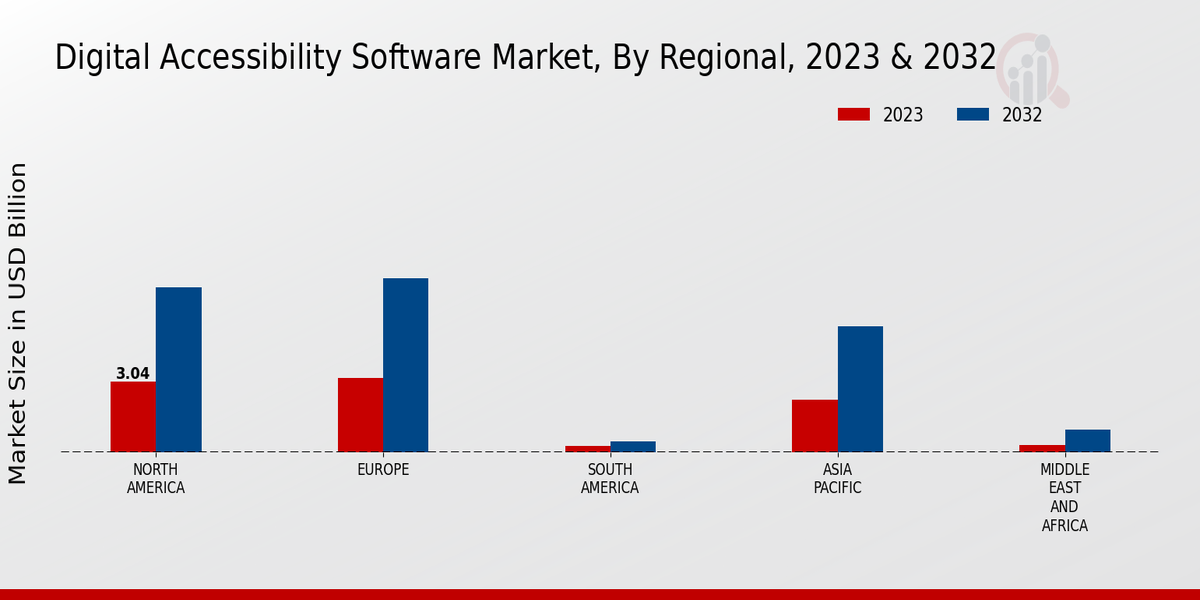Market Growth Projections
The Global Digital Accessibility Software Market Industry is projected to experience substantial growth over the next decade. The market is expected to reach 4.02 USD Billion in 2024 and is anticipated to expand to 14.1 USD Billion by 2035. This growth trajectory suggests a compound annual growth rate (CAGR) of 12.09% from 2025 to 2035. Such projections indicate a robust demand for digital accessibility solutions as organizations increasingly prioritize inclusivity and compliance with regulatory standards. The upward trend in market size underscores the critical role of digital accessibility in fostering equitable digital experiences.
Technological Advancements
Technological innovations are playing a pivotal role in shaping the Global Digital Accessibility Software Market Industry. The emergence of artificial intelligence and machine learning technologies has led to the development of sophisticated accessibility tools that can automatically identify and rectify accessibility issues in digital content. These advancements not only streamline the accessibility process but also enhance the effectiveness of compliance measures. As organizations increasingly adopt these technologies, the market is likely to witness a compound annual growth rate (CAGR) of 12.09% from 2025 to 2035, indicating a robust trajectory fueled by technological progress.
Rising Awareness of Inclusivity
There is a growing recognition of the importance of inclusivity in the digital realm, which significantly influences the Global Digital Accessibility Software Market Industry. Organizations are increasingly aware that accessible digital content not only benefits individuals with disabilities but also enhances overall user experience. This awareness is reflected in corporate social responsibility initiatives, where companies strive to create inclusive environments. As businesses prioritize accessibility, the demand for digital accessibility software is expected to surge, contributing to a projected market growth to 14.1 USD Billion by 2035. This shift indicates a broader societal commitment to inclusivity.
Increasing Regulatory Compliance
The Global Digital Accessibility Software Market Industry is experiencing growth driven by stringent regulatory requirements aimed at ensuring digital inclusivity. Governments across various regions are implementing laws that mandate accessibility standards for websites and applications. For instance, the Americans with Disabilities Act (ADA) in the United States and the European Accessibility Act in Europe have set clear guidelines. This regulatory landscape compels organizations to adopt digital accessibility solutions to avoid legal repercussions. As a result, the market is projected to reach 4.02 USD Billion in 2024, with compliance being a critical driver for investment in accessibility software.
Expansion of E-Commerce Platforms
The rapid expansion of e-commerce platforms is significantly impacting the Global Digital Accessibility Software Market Industry. As more businesses transition to online sales, the need for accessible digital storefronts becomes increasingly critical. E-commerce companies are recognizing that an accessible website not only broadens their customer base but also enhances brand reputation. This realization is driving investments in digital accessibility solutions to ensure compliance with accessibility standards. Consequently, the market is poised for substantial growth, reflecting the increasing integration of accessibility into the e-commerce sector.
Growing Demand from Educational Institutions
Educational institutions are increasingly recognizing the necessity of digital accessibility, thereby driving growth in the Global Digital Accessibility Software Market Industry. With the rise of online learning platforms, ensuring that educational content is accessible to all students, including those with disabilities, has become paramount. Many institutions are adopting accessibility software to comply with educational regulations and to foster an inclusive learning environment. This trend is expected to contribute to the market's expansion, as educational bodies invest in tools that facilitate equal access to digital resources, further solidifying the industry's relevance.























